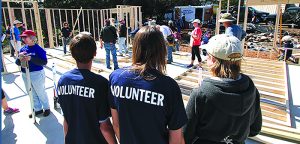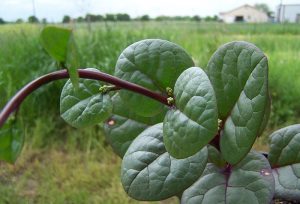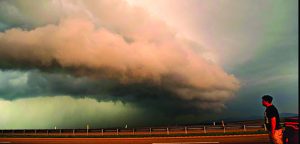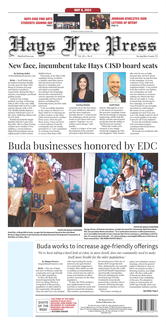by Paige Lambert
Doug Moreland, of Manchaca, checked the rainwater pipes that led to a five-gallon water jug.
The almost full jug marked hundreds of gallons of rainwater the Moreland family has conserved just from their roof.
The use of rainwater for drinking, irrigation and conservation has been a growing trend for decades, said Alan Rossing, owner of Lakota Water Company.
When he started his rainwater business in 2000, Hays County had more rainwater related businesses than the rest of the United States, Rossing said.
“Now it’s to the point where we are booked 12 months in advance,” Rossing said. “The whole green movement really helped build momentum.”
He said there are now about 1,600 rainwater businesses in Texas and 2,600 in the United States.
The rainwater industry has exploded because the systems and installation practices are safer and more uniform, he said.
Chris Maxwell-Gaines, Texas Rainwater Collection Association president, said the organization is trying to create a certification program with the Texas Department of Agriculture for installers.
“There are a lot of gray areas installers have to know, so we want the public to know they are legitimate,” Maxwell-Gaines said. “We want to let them know this profession is professional.”
The industry’s growth is largely a reflection of Central Texans wanting alternatives to well water, Rossing said.
He said many of his customers built homes connected to well water only to have their systems fail within four years. One customer drilled a well three times and ended up spending $20,000 to no avail, he said.
“I hear stories of people paying $25,000 for a well and if they don’t hit water they have to pay that again,” Rossing said. “It happens because we are in a constant drought and so many people are pulling out water.”
A rainwater system for a family of four can cost $21,000 to $32,000 with about $250 in annual maintenance, depending on the house, he said.
Rossing said Hays County residents also get a property tax exemption for their system.
The price of well drilling has easily reached the same price tag as rainwater collection and will continue to increase as less groundwater is available, said Karen Ford of the Hill Country Alliance.
“Folks are forging ahead in being independent of utility because the cost of water is going up,” Ford said. “There is really no guarantee of groundwater.”
Ford said she has seen more people and even neighborhoods use rainwater just for irrigation. Residents save money if it is only used for irrigation since unfiltered, or gray water, can be used on plants.
Suzy Moreland, Doug’s wife, said the gray water has helped her plants recover from the well water they would use before.
“The groundwater always left this white residue, which is the calcium in the water,” Suzy said. “But when you use the rainwater, it makes the plant grow cleaner and better.”
On a sunny day, the system easily collects ten gallons of water, Doug said. The system is able to stock up enough water to see them through winter or cloudy seasons, and has never run dry, he said.
In only a year, Doug can instantly feel the difference of drinking distilled rainwater versus well or city water. The Moreland family uses two solar panels to distill the rainwater which connects to five gallon jugs.
“The hard water is what we’ve learned affects joints, eyesight, and anything fluid in your body,” Doug said. “We are just trying to drink the cleanest, purist water possible.”
Suzy said installing a potable rainwater system is not for everyone, however. Before the system was installed, the couple conducted extensive research and has to perform regular maintenance on the system.
If a home is in a city’s limits, the rainwater system also has to be connected to utility as back up and is held to higher purification standards, Maxwell-Gaines said.
“Once you start factoring in everything it gets really complicated,” Maxwell-Gaines said. “But I’ve seen people swap out small systems just for the better quality of water.”
While the pros, cons and installation of rainwater systems are a lot to comprehend, more organizations are trying to provide education about this alternative water source, Ford said.
Hill Country Alliance is on its seventh year of hosting the Rainwater Revival, which serves as an educational and networking hub for rainwater enthusiasts.
Rossing said his company has also installed commercial sized systems for businesses and some schools in San Antonio. During installations, his company usually shows students the system and educates them about rainwater.
“There’s a lot of people my age who are put off by rainwater systems,” Rossing said. “It’s great that they are actually teaching young students about rainwater.”
Suzy said the couple’s next step is to get completely off the grid with a windmill. She said she hopes more people will take the next step in water conservation, whether it’s for potable water or just irrigation.
“You can’t overwhelm yourself by trying to do it all at once,” Suzy said. “You have to kind of change the mind-set of your typical American lifestyle.”










